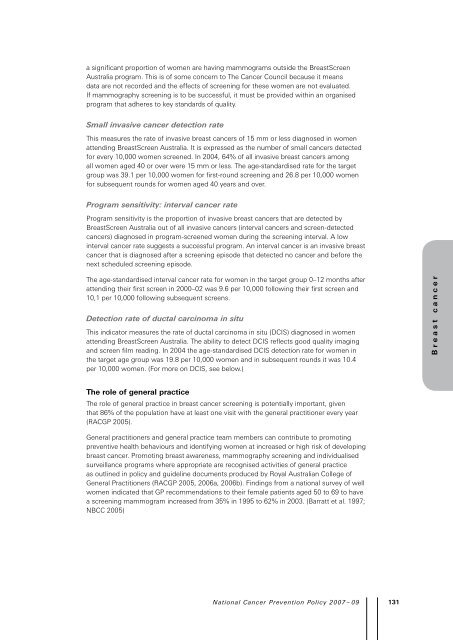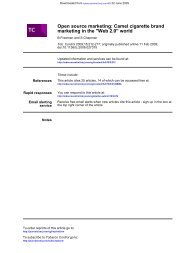National Cancer Prevention Policy - Tobacco Control Supersite
National Cancer Prevention Policy - Tobacco Control Supersite
National Cancer Prevention Policy - Tobacco Control Supersite
Create successful ePaper yourself
Turn your PDF publications into a flip-book with our unique Google optimized e-Paper software.
a significant proportion of women are having mammograms outside the BreastScreen<br />
Australia program. This is of some concern to The <strong>Cancer</strong> Council because it means<br />
data are not recorded and the effects of screening for these women are not evaluated.<br />
If mammography screening is to be successful, it must be provided within an organised<br />
program that adheres to key standards of quality.<br />
Small invasive cancer detection rate<br />
This measures the rate of invasive breast cancers of 15 mm or less diagnosed in women<br />
attending BreastScreen Australia. It is expressed as the number of small cancers detected<br />
for every 10,000 women screened. In 2004, 64% of all invasive breast cancers among<br />
all women aged 40 or over were 15 mm or less. The age-standardised rate for the target<br />
group was 39.1 per 10,000 women for first-round screening and 26.8 per 10,000 women<br />
for subsequent rounds for women aged 40 years and over.<br />
Program sensitivity: interval cancer rate<br />
Program sensitivity is the proportion of invasive breast cancers that are detected by<br />
BreastScreen Australia out of all invasive cancers (interval cancers and screen-detected<br />
cancers) diagnosed in program-screened women during the screening interval. A low<br />
interval cancer rate suggests a successful program. An interval cancer is an invasive breast<br />
cancer that is diagnosed after a screening episode that detected no cancer and before the<br />
next scheduled screening episode.<br />
The age-standardised interval cancer rate for women in the target group 0–12 months after<br />
attending their first screen in 2000–02 was 9.6 per 10,000 following their first screen and<br />
10,1 per 10,000 following subsequent screens.<br />
Detection rate of ductal carcinoma in situ<br />
This indicator measures the rate of ductal carcinoma in situ (DCIS) diagnosed in women<br />
attending BreastScreen Australia. The ability to detect DCIS reflects good quality imaging<br />
and screen film reading. In 2004 the age-standardised DCIS detection rate for women in<br />
the target age group was 19.8 per 10,000 women and in subsequent rounds it was 10.4<br />
per 10,000 women. (For more on DCIS, see below.)<br />
The role of general practice<br />
The role of general practice in breast cancer screening is potentially important, given<br />
that 86% of the population have at least one visit with the general practitioner every year<br />
(RACGP 2005).<br />
General practitioners and general practice team members can contribute to promoting<br />
preventive health behaviours and identifying women at increased or high risk of developing<br />
breast cancer. Promoting breast awareness, mammography screening and individualised<br />
surveillance programs where appropriate are recognised activities of general practice<br />
as outlined in policy and guideline documents produced by Royal Australian College of<br />
General Practitioners (RACGP 2005, 2006a, 2006b). Findings from a national survey of well<br />
women indicated that GP recommendations to their female patients aged 50 to 69 to have<br />
a screening mammogram increased from 35% in 1995 to 62% in 2003. (Barratt et al. 1997;<br />
NBCC 2005)<br />
<strong>National</strong> <strong>Cancer</strong> <strong>Prevention</strong> <strong>Policy</strong> 2007 – 09<br />
131<br />
B r e a s t c a n c e r




